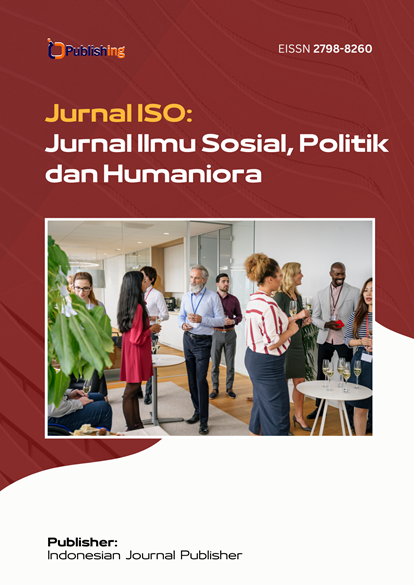Ageing Society: Tantangan Dan Strategi Model Pentahelix Di Kabupaten Gunungkidul
DOI:
https://doi.org/10.53697/iso.v4i2.1844Keywords:
Lansia, Pemangku Kepentingan, Kesejahteraan SosialAbstract
Periode kehidupan seorang lanjut usia (lansia) mengalami penurunan baik fisik dan sosial. Hal ini menimbulkan permasalahan dan ketergantungan pada kelompok lebih muda. Tulisan ini akan memberikan konsep dan pemikiran terkait isu peningkatan kesejahteraan sosial lansia melalui model pentahelix. Model pentahelix ini dapat sebagai strategi bagi pemangku kepentingan untuk mengkolaborasikan pengetahuan dan keterampilan dalam peningkatan kesejahteraan sosial lansia. Pemangku kepentingan yang dimaksud yaitu akademisi, perusahaan melalui program Corporate Social Responsibility (CSR), masyarakat, media dan pemerintah. Penelitian ini akan dilakukan melalui pendekatan kualitatif deskriptif menggunakan analisa soft ware Nvivo 12 plus. Melalui penelitian ini dapat menghasilkan rekomendasi atas dasar kajian literatur yang telah dilakukan dengan tujuan peningkatan program layanan kesejahteraan sosial lansia lintas pemangku kepentingan.
References
ANGESTI, N. V. (2021). Age-friendly Communities and Regional Disparity: The Case of Indonesia (Doctoral dissertation, Universitas Gadjah Mada).
Arszandi Pratama, S. T., & ST, D. M. F. Mempelajari Konsep Tata Ruang Ramah Lansia.
Aqila, A. R., Purnaweni, H., & Priyadi, B. P. (2023). KEBIJAKAN PEMERINTAH KOTA SEMARANG DALAM MEWUJUDKAN KOTA RAMAH LANSIA. Journal of Public Policy and Management Review, 12(3), 645-665.
Black, K., & Oh, P. (2022). Assessing age-friendly community progress: What have we learned?. The Gerontologist, 62(1), 6-17.
Chao, T. S., & Huang, H. (2016). The East Asian age-friendly cities promotion–Taiwan’s experience and the need for an oriental paradigm. Global Health Promotion, 23(1_suppl), 85-89.
Campus, U. I., Campus, U. I., Campus, U. I., Campus, U. I., & Campus, U. I. (2014). The assessment of Depok as age friendly city (AFC). Journal of Biosciences and Medicines, 2(06), 5.
Diansari, S. A., & Tanti, B. S. (2019, November). INDONESIA'S EFFORTS IN IMPLEMENTING THE INTERNATIONAL REGIME ON AGEING THROUGH AGE-FRIENDLY CIT
Erwanto, R., Kurniasih, D. E., & Amigo, T. A. E. (2020). Pengembangan Dusun Ramah Lansia Melalui Pelaksanaan Sekolah Lansia Di Karet Kabupaten Bantul. JMM (Jurnal Masyarakat Mandiri), 4(6), 1334-1344.
Falikhah, N. (2017). Bonus demografi peluang dan tantangan bagi Indonesia. Alhadharah: Jurnal Ilmu Dakwah, 16(32). Y ON 2030. In Proceeding International Conference (Vol. 1, No. 1, pp. 379-385).
Fatmah, F., Dewi, V. P., & Priotomo, Y. (2019). Developing age-friendly city readiness: A case study from Depok city, Indonesia. SAGE Open Medicine, 7, 2050312119852510.
Fitzgerald, K. G., & Caro, F. G. (2014). An overview of age-friendly cities and communities around the world. Journal of aging & social policy, 26(1-2), 1-18.
Irwansyah, I., & Ernungtyas, N. F. (2023). Age-Friendly environment: A systematic literature review. In E3S Web of Conferences (Vol. 452, p. 07009). EDP Sciences.
Hermawati, I., & Sos, M. (2015). Kajian tentang kota ramah lanjut usia. Yogyakarta: Badan Pendidikan dan Penelitian Kesejahteraan Sosial Balai Besar Penelitian dan Pengembangan Pelayanan Kesejahteraan Sosial (B2P3KS).
Moulaert, T., & Garon, S. (2016). Age-friendly cities and communities in international comparison. Cham, CHE: Springer International.
Menec, V. H., Means, R., Keating, N., Parkhurst, G., & Eales, J. (2011). Conceptualizing age-friendly communities. Canadian Journal on Aging/La revue canadienne du vieillissement, 30(3), 479-493.
Meeks, S. (2022). Age-friendly communities: Introduction to the special issue. The Gerontologist, 62(1), 1-5.
Menec, V., & Novek, S. (2020). Making rural communities age-friendly: Issues and challenges. Rural Gerontology, 164-174.
Neville, S., Napier, S., Adams, J., Wham, C., & Jackson, D. (2016). An integrative review of the factors related to building age‐friendly rural communities. Journal of Clinical Nursing, 25(17-18), 2402-2412.
Russell, E., Skinner, M. W., & Colibaba, A. (2021). Developing rural insights for building age-friendly communities. Journal of rural studies, 81, 336-344.
Sardjono, W., Kusnoputranto, H., Utomo, H., & Sukardi, S. Community Participation in Urban Development in Realizing an Elderly Friendly City in Indonesia.
Savitri, A. (2019). Bonus Demografi 2030: menjawab tantangan serta peluang edukasi 4.0 dan revolusi bisnis 4.0. Penerbit Genesis.
Suriastini, W., Buffardi, A. L., & Fauzan, J. (2019). What prompts policy change? Comparative analyses of efforts to create age-friendly cities in 14 cities in Indonesia. Journal of Aging & Social Policy, 31(3), 250-270.
Sir, D. P. S., Tambunan, S. S., Putri, A., & Gurning, F. P. (2023). Tantangan Dan Peluang Pembiayaan Kesehatan Di Indonesia Sebuah Tinjauan Literatur. Jurnal Kesehatan, 1(6), 893-901.
Torku, A., Chan, A. P. C., & Yung, E. H. K. (2021). Age-friendly cities and communities: A review and future directions. Ageing & Society, 41(10), 2242-2279.
Tiraphat, S., Buntup, D., Munisamy, M., Nguyen, T. H., Yuasa, M., Nyein Aung, M., & Hpone Myint, A. (2020). Age-friendly environments in ASEAN plus three: Case studies from Japan, Malaysia, Myanmar, Vietnam, and Thailand. International journal of environmental research and public health, 17(12), 4523.
Phillips, D. R., Woo, J., Cheung, F., Wong, M., & Chau, P. H. (2018). Exploring the age-friendliness of Hong Kong: opportunities, initiatives and challenges in an ageing Asian city. In Age-Friendly Cities and Communities (pp. 119-142). Policy Press.
Sun, Y., Chao, T. Y. S., Au, D. W., Yung, E. H., & Woo, J. (2022). The age-friendly movement in an Asian context. In The Age-friendly Lens (pp. 89-103). Routledge.
Xie, L. (2018). Age-friendly communities and life satisfaction among the elderly in urban China. Research on aging, 40(9), 883-905.
Xiang, L., Tan, Y., Jin, X., & Shen, G. (2021). Understanding stakeholders' concerns of age-friendly communities at the briefing stage: a preliminary study in urban China. Engineering, Construction and Architectural Management, 28(1), 31-54.
Wang, Y., Gonzales, E., & Morrow-Howell, N. (2017). Applying WHO’s age-friendly communities framework to a national survey in China. Journal of Gerontological Social Work, 60(3), 215-231.
van Hoof, J., & Marston, H. R. (2021). Age-friendly cities and communities: State of the art and future perspectives. International journal of environmental research and public health, 18(4), 1644.
Vibriyanti, D. (2019). Surabaya menuju kota ramah lansia: peluang dan tantangan. Jurnal Kependudukan Indonesia, 13(2), 117-132.
Downloads
Published
How to Cite
Issue
Section
License
Copyright (c) 2024 Hani Puspita Dewi, Alma Febriana, Silvia Arnita Prabintari

This work is licensed under a Creative Commons Attribution 4.0 International License.













